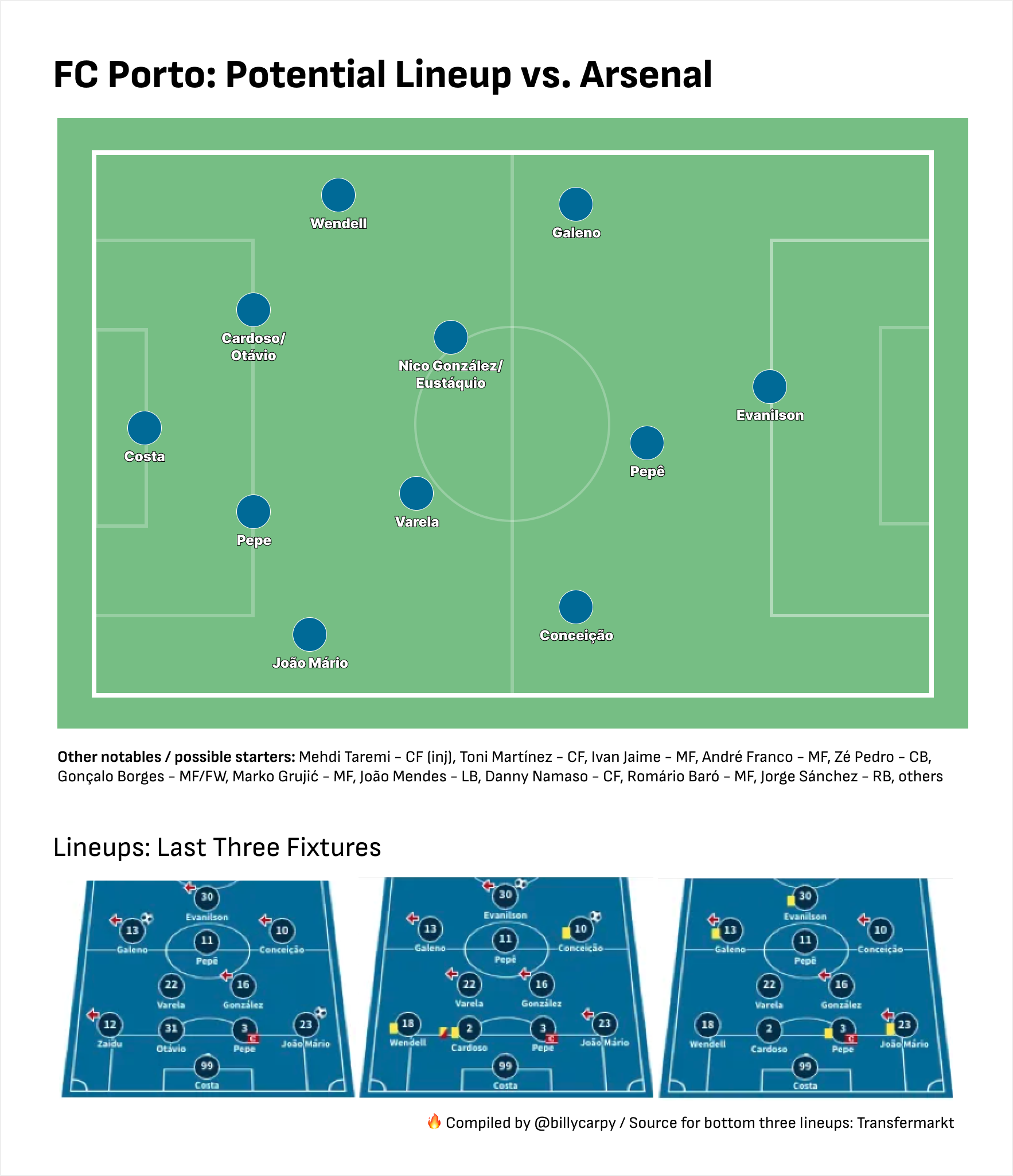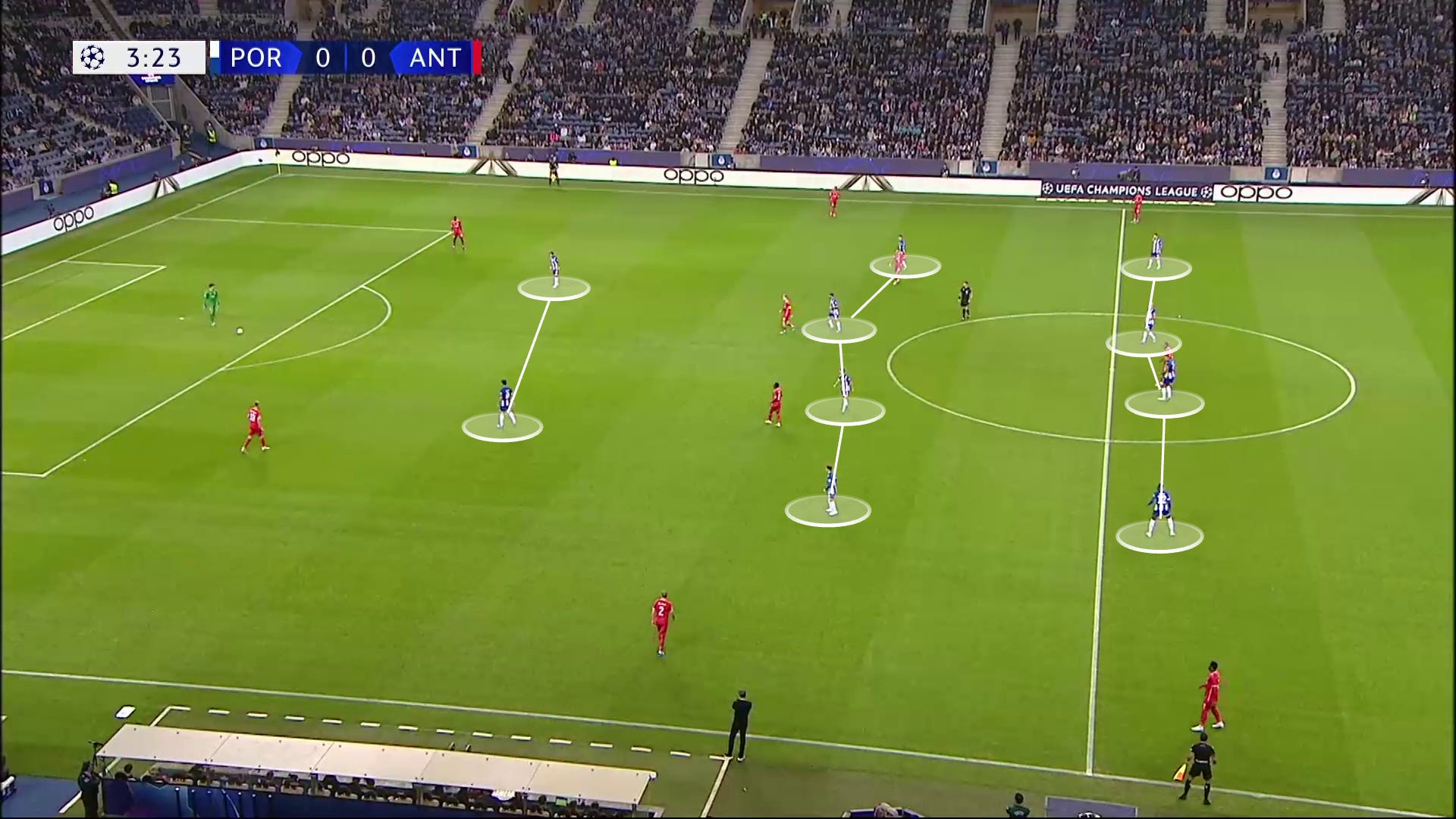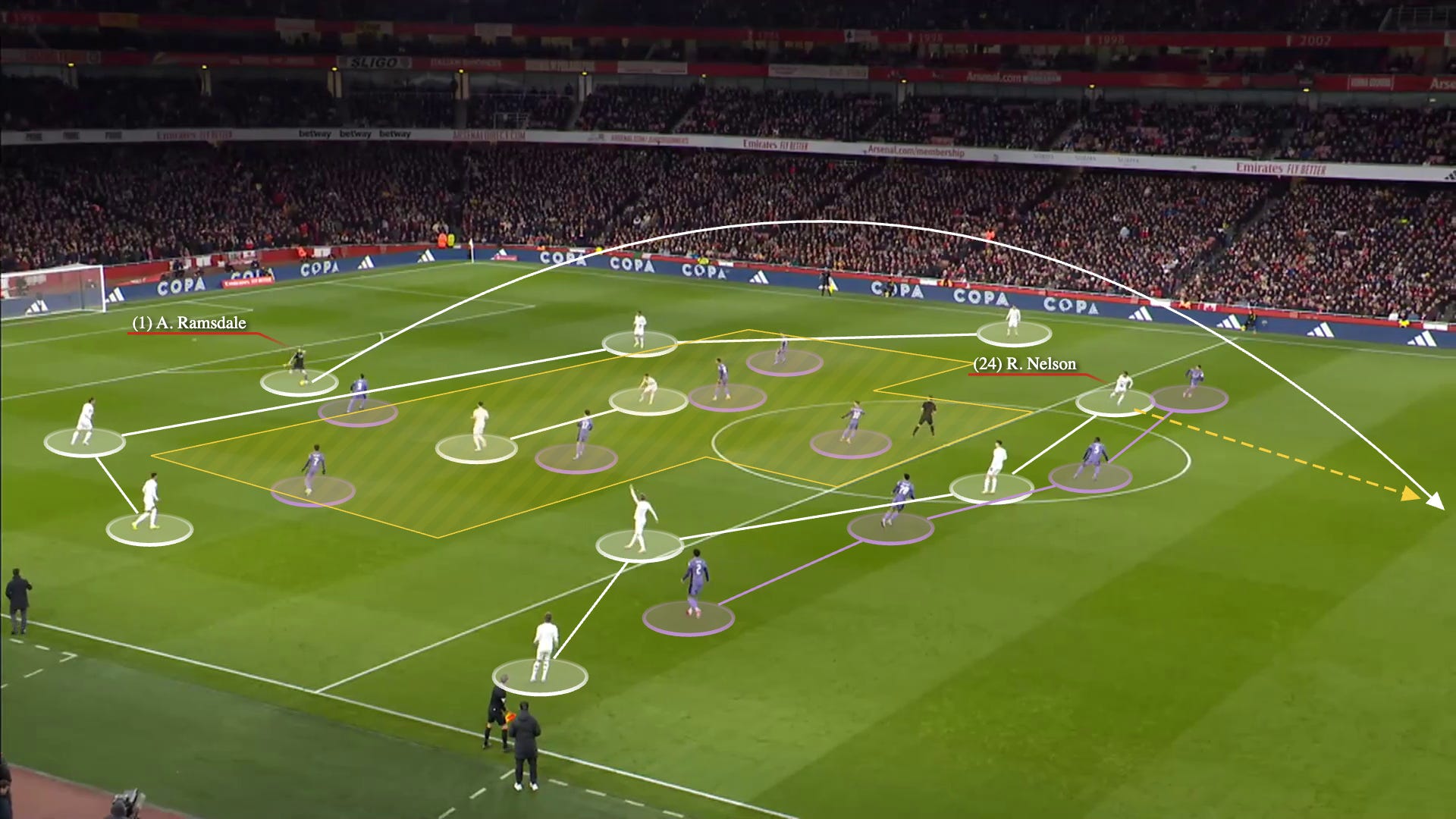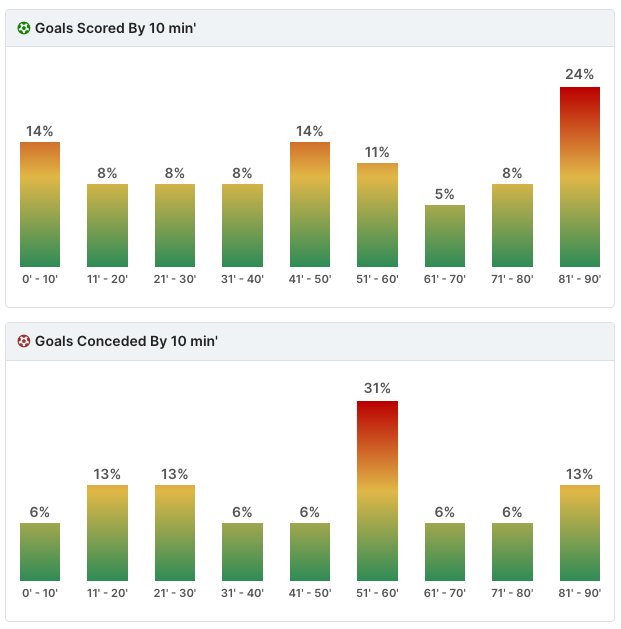Scouting FC Porto
An opposition analysis of Arsenal’s opponents in the round of 16. Looking at their game model, tactics, preferences, strengths, and weaknesses — then, some specific ways to come out on top
The Champions League anthem beckons for Arsenal tomorrow, and we’re here to talk about our opponent in that one. But there was a 5-0 win against Burnley on Saturday.
We’ve covered the tactical underpinnings of all that at length. While much of the foundation for the current run of form was laid in the months prior, there have been some interesting tweaks of late. This includes, most notably, Ben White inverting. There are other cascading variables to consider — Gabriel swinging into the middle, Saliba swinging wider, Kiwior as a “reverse Ben White” on the left side, and Trossard/Havertz partnering up.
All told, the game against Burnley was probably more reason for optimism than the bigger thrashing doled out to West Ham. There was some latent unsteadiness in the first half of the one against the Hammers before the goal machine when brrrrr with a set piece, a penalty, and another set piece.
Against Burnley — a simply worse side, mind you — the opponent was much less willing to get drawn out of their block. As such, a lot of rotations couldn’t flow naturally in deep build-up, because deep build-up was largely unnecessary. The fluidity had to be stubbornly manufactured higher up the pitch, which is something that Arsenal have struggled with in the olden days (you know, any time before December … but also including December’s games against West Ham and Fulham).
They cracked the code against Burnley, and the little details actually looked much sharper than the previous go.
The trajectory is upward.
⏭ Next up, Porto
Now it’s time to take that trajectory back to the Champions League, and see whether it will be built upon — or interrupted. Europe is a different beast, as we know too well.
Kai Havertz, for one, returns to the Estádio do Dragão after scoring the lone goal in the Champions League final back in 2021.
“For me, it will always be a nice memory, so I am looking forward to playing there again,” said Havertz. “I have good memories there, and things that are always going to be in my heart in the future. Every team that plays in the Champions League wants to win it. In the end, that’s the goal of every team.”
Arsenal are set to face Porto, who finished even with Barcelona atop Group H (which was the lowest-rated group), bouncing Shakhtar Donetsk and Antwerp from the competition. Some may see this as a relatively fortunate draw.
I still see it as a tricky one.
Sérgio Conceição replaced Nuno Espírito Santo in 2017 and has been leading the side ever since, shepherding three league wins in that time, including that one in 21-22 with a certain skinny do-it-all attacking midfielder with a ridiculous final ball notching 17 G+A. I’m talking about Fábio Vieira, you fool.
Conceição’s team has been sharp at home thus far. The pressing is a little pressier, the passing a little bit more direct, the tempo a little higher. The performances reflect this, per Opta.
Home
xGD/90: +1.55 per 90
Overall: 8-2-1 with 19 G and 5 GA
Away
xGD/90: +0.06 per 90
Overall: 7-1-3 with 18 G and 11 GA.
Let’s dive in to better understand where they are in general.
🤔 How has the team changed?
Here’s a screenshot of the team’s transfer business in the last year.
In keeping up with the team’s dedication to confusing us in appellative matters, they recently signed an Otávio to replace the previous one — while starting two Pepes and one João Mário.
The primary reinforcements have been in the midfield after seeing Uribe pack his bags to Qatar. Nico came along from Barcelona, and you may remember Alan Varela, who ranked 22nd in our rankings of defensive midfielder options at one point.
From there, Conceição’s son, Francisco, is playing on loan from Ajax (reportedly with an option to buy), and getting a lot of minutes at right-wing. Iván Jaime looks like an awfully nice, slick talent to me.
⚽️ Overview
In many ways, they are a difficult side to prepare for. While I’ve watched, I haven’t necessarily gotten that sinking feeling — oh shit, how are we going to mark that guy? — but I haven’t found too many obvious vulnerabilities, either. This is a credit to the work of Conceição.
In general, I would describe them as disciplined, compact, and annoying to face; they jump when you don’t want them to jump, they don’t jump when you do want them to, and they turn the game into a scrapfest with fouls aplenty. From there, they look to be decisive, relying on a lot of intuition and personal judgment in the attacking half. They have bursts of (somewhat inconsistent) attacking quality.
They also have been undergoing some tactical tweaks.
Conceição is known for his 4-4-2 approach, but it’s evolved into more of a 4-2-3-1 of late, with a high midfielder joining the striker and helping a bit more with progression. Much of the foundation remains the same, but they seem a little more solid for the tweaks — but have also had a relatively easy run of fixtures in the past month or so. A 3-2 defeat at Arouca was a huge blow to their title chances (and their odds of making the Champions League again).
All in all, it’s hard to tell. It’s best to plan for the worst.
💠 Shapes and lineups
To prepare for this piece, I watched back both of Porto’s games against Barcelona, as well as those against Shakhtar and Antwerp. I speed-ran much of their recent run of fixtures, and checked in on a lot of clips from Sporting CP, Benfica, and Braga — as well as highlights and duels elsewhere. Barcelona felt the most instructive to how Porto may line up here. In any case, I still have plenty of blind spots, so proceed accordingly.
With that, here’s my best, bullshitty guess as to how they may line up.
From there, I wanted to try a new view — combining a view of a lineup with graphs from FBCharts. If it’s looking pretty pixelated, you can save the picture and zoom in and around, I think.
Some notes:
Unless I’m missing something, the big lineup decisions for Porto may loom at LCB and LCM.
At left centre-back, Fábio Cardoso has started most games, and has some impressive on-ball statistics, as well as experience and steadiness that a manager may seek in one like this. Otávio, just signed from Famalicão, looks like a talented prospect.
At CM, Alan Varela is most likely a nailed-on starter. He could be joined by Nico González (who has been starting of late) or Stephen Eustáquio, who missed last game completely and may still be out.
Frontline: Evanilson is a really nice all-around striker. He’s just good at most things. I’ve seen a lot of thoughtful hold-up play, as well as clever little touches to play his teammates in. His best quality may be his savvy movement. He’s strong but not too huge; fast enough but not world-class, whatever that means. He’s just good, and has been showing it for most of the year … On the wings, we have Galeno, who has been ripping it up in the UCL, and is a great carrier down the left wing. He floats around looking to make things happen, and kind of has a poacher’s mindset … On the other side, Conceição is tiny but so quick and agile, and looks to be players on the dribble before playing it into the penalty area. He’s also ripped a lot of shots, and has been their most dynamic threat of late … Pepê (the flexible attacker, not the defender, or, you know, Pépé) strings it all together. A year or two ago, at a slightly different stage in the project, he was always on my mind for Arsenal — as a floor-raising, smart, creative force who you’d feel comfortable starting on the wing, in the attacking midfield spots, or even as a wing-back in a pinch. He takes risks and his little through-balls pose one of the bigger risks for Arsenal. He hasn’t looked quite as dangerous as before.
Midfield: Varela has been one of the steadiest performers for the team since joining from Boca Juniors. I could see him getting a jump to a mid-table Premier League club … On the other side of the pivot, Nico has been looking good of late, and complements Varela well. Eustáquio offers a lot of qualities but I tend to think Nico is more additive.
Backline: At left-back, Wendell looks a little bit up-and-down, but when I’ve seen him up, he looks like such an interesting, dynamic force down the left flank; he has ideas. João Mário is a solid all-around full-back who is good at carrying it up into the final third and whipping in a decent amount of crosses. He’s fast in big spaces but I can see him getting turned by Martinelli. The 40-year-old Pepe marshalls things from the back. He honestly still looks good — it is weird how fast and quick he still is. He communicates so much and looks to dominate the boxes, has lost a little of his aerial shine, but is still aggressive — he has two costly red cards in Clasicos this year. I’d like to see Havertz and Martinelli giving him some tough choices … At LCB, see above.
GK: It’s Costa, who is probably their best player. Not only does he do well in shot-stopping metrics, he’s a beast on corners, and leads the team in progression.
Otherwise: Mehdi Taremi has been such a cog over the years, notching 112 G+A in the league in his Porto career, but is looking like he’ll be out for this one. If so, that loss may be felt less than usual, as the team had been tweaking tactics while he was away, and have found something that is working without him; he may have been on the bench anyway. Still — Opta credits him with 21 shots in 6 Champions League games this year, including 2 goals and 2 assists … In his stead, Toni Martínez is a great rotational option at striker. He’s big, fast, and has a good shot in him; it feels like he should be starting somewhere … As I’ve said elsewhere, I think Iván Jaime is a real talent, and a dangerous option off the bench … There are a bunch of others but I’m tired.
Other than that, the lineup has been pretty steady.
In general, you’ll see how the team has evolved in terms of the overall formations they’ve presented — with a lot more 4-2-3-1 of late.
Let’s look at what they do in the different phases.
👉 Out of possession
In the league, they boast a 6.76 PPDA (passes allowed per defensive action), which is an approximation of the intensity of your high press: i.e., how many passes the team allows in the opponent’s 60% of the pitch without doing something about it.
That would seemingly point to a very heavy-metal pressing philosophy. They also have the highest intensity in the league, as measured by [duels, tackles and interceptions] per [minute of opponent possession].
And they indeed go full-beans in a fairly top-heavy Primeira Liga. But the reality from there is a little bit more nuanced and interesting.
The numbers in defensive formations like these don’t matter a whole lot — it’s all about individual player responsibilities and triggers — but they do offer us a shortcut to understanding. Porto have laid off a bit more in their more important matchups, and I would tend to expect a very solid, compact, 4-4-2 like you see below against Antwerp. Who knows, it may get really low.
Against Barcelona, you saw a slightly adjusted look based on the opponent's build-up shape. Galeno had hybrid responsibilities out wide, where he’d join the frontline or drop back depending on the placement of the ball and Araújo. Varela was also very active about stepping up to follow players up to certain points.
In this rendition, they are looking to stick together: to keep themselves from getting baited too far forward, and to make sure their mid-to-high backline isn’t left exposed. To do this, they are likely to lower their line of engagement a bit, and they will also give up progression to the flanks.
There will be moments in the game where I’d expect a higher press, probably even early. From there, the triggers will probably relax, and they’ll hope to funnel some possession into the middle; once the ball reaches the crowded spaces, they’re extra aggressive, and can be skilled at tapping it away around the centre-circle and transitioning from there. Opponents can have more luck when they bait that aggression and then exploit it in the wide areas.
In the league, they haven’t given up a lot of goals in open play to date.
The shots usually come from the middle, as they often do.
In sum: there are a lot of steady defenders here, culminating in the second-best xGA in the league. They are tireless and have a specific philosophy. They are aggressive, and can definitely turn up the shit-housing; their 69 yellow cards (nice) are good for second in the league.
👉 In possession
They are a generally high-possession, deep build-up team. They have the highest possession in the league (with 61.9%), and are usually building in a 4-2-2-2 shape that we’ve become familiar with — and that we see below.
They don’t have much of a reason to go long in a “Target Man” type of way. The frontline they will likely start won’t have many physical advantages against the Arsenal backline. In back, they have the second-lowest launch percentage in Portugal, but do try to play it in over the top a fair amount.
In general, the build-up is pragmatic and clean, starting with Costa in back, who adds a lot of solidity to everything. There are no bang-obvious triggers, but I think Arsenal have the possibility of getting the ball off almost everybody else if they time their challenges right; the double-pivot isn’t the kind that is going to be able to out-size or out-run the Arsenal configuration. They generally progress through the middle.
Wendell at left-back has often impressed me with his forward movement (although his performances seem spotty), and João Mário at right-back offers a little bit of everything. Their speed is reason to pause a bit with your aggression, as they can carry it up through the wide areas and flow attacks in from there.
The attacks are evenly distributed down each wing.
As progression moves forward, especially late, you’ll see Pepê floating above the pivot. He’s providing a lot of the role that used to be helmed by another striker in this system, but he’s doing it while adding a little bit more help to the midfield. I’ve highlighted some of the options available to different players in rotation.
And with the forward pairing moving around and the winger tucking inside, you’ll see how Porto tries to generate threat into these wing areas by sending their full-backs forward.
For this reason, the speed of Kiwior and the wide 1v1 ability of Gabriel look like a good match for this one.
In general, there is a specific chain through progression that I’d be most interested in disrupting. It’s when the ball flows from Pepe to Varela and up to the more advanced Pepê. Here’s an idea of their progression in the last five games:
Once the ball gets up to Attacking Pepê in good circumstances, he’s great at dishing it out — and his through-balls are a particular threat in this one. Evanilson is great at associative runs and angles, and White and Saliba should be on guard.
They are able to score in a few different ways, but take a lot of shots to do it; they require 10 shots on target for every goal. Why do I feel like it’s bad luck to type that?
And the other threat is on the dribble, particularly on the right wing with Francisco Conceição. He’s been burning people lately and getting shots off. He’s the individual player I’m most worried about.
👉 Set plays
This is a strength-versus-strength showdown, with Costa and Pepe using all their tricks against the best set-play team in the Premier League.
Porto, like Arsenal, are able to generate a lot of corners for themselves, and generally handle them with inswingers. They also get a lot of free kicks from fouls; one fan’s “savviness” is another fan’s “flopping.”
Here are corners from the last five.
Here’s Costa:
I didn’t see a single corner kick goal against Porto all year, and Opta only credits their opponents with one last year.
It’s a tough matchup. There’s a good chance this has to be won in open play.
🔥 A few areas of emphasis
OK, let’s wrap it up with a few key areas to focus on — outside of the more obvious things.
1. Make the compact block not compact
At home, they may bring an all-out press at certain points, and I wouldn’t be surprised to see it early. But I think it’s more likely that they settle into an immoveable block in the middle of the pitch, with players close together.
Barelona offered us one way through. Below, you’ll see Koundé generating inertia to one side of the pitch, and then passing against that inertia — often referred to as “manipulating flow.” The players get moving in one direction, and then the pass can go the other direction so fast they can’t keep up.
But what you also see here is that a block is that isn’t always jumpy gets really swarmy and aggressive in the middle of the pitch. This is their happy place — they want to win the ball back here. It is not for the faint of heart, but players like Ødegaard and Jorginho can operate in these spaces, attract a hive, and then dish it out to the other wing as quickly as possible.
Here’s a screenshot of the moment that shows how the far-side wing is left open.
And here, we have the results. Their midfielders have great stamina but aren’t always fast enough to roam from side to side quick enough, and one of our wingers should be able to win a pure 1v1 against their full-backs.
While that was Cancelo there, these are the kinds of immediate switches you’d like to manufacture situations for our wingers. You’ll see João Félix pulling players inside as well to give Cancelo enough space to shoot. Like Havertz might.
My general feeling here? They’re trying to stop progression into the middle, and they will probably have some success in doing so. But I think there are times when we can force it, get swarmed, and pass out of it.
2. Bait wingers (mainly Galeno) forward
As you’ll see, Galeno has a lot of responsibility out here, and is not willing to jump at anything. If you’re able to get his attention (a faux long touch, or dribbling towards him, for example), you can get it out to the wing for a wide 1v1. Look how open that space is here.
For this reason, I also forsee White floating up to the wing while Saka peeks inside into that left half-space position.
3. Bait everyone and go long
Again, they tend to play medium-to-high, even against good teams. If you’re able to discern their pressing triggers, you can pull one or more of the players closer to your box. This will have the add-on effect of the other players wanting to nudge forward.
This may be a possibility.
4. Force tough decisions between the full-back and CB positions
The Porto full-backs tend to get up the pitch, though I expect them to be more conservative here. With that said, there should be some opportunities to exploit the space between the full-back and the CB, as we saw against Liverpool.
Perhaps Pepe has commendable speed for a 40-year-old, but it should be tested by Martinelli.
5. Other stuff
OK, I’ve got a laundry list of other stuff, and I’m not feeling too hot. Let’s get this thing done quick.
Switches after throw-ins: Porto, like many teams, use an aggressive ball-side lean. They are compact in the direction of the throw-in. If you can pass your way out of that and to the other side, you have free real estate. On their own throw-ins, they can throw Pepe forward, which leaves them more vulnerable to transition.
Pressing triggers: My preference is to have a relatively relaxed first line of press, allowing Costa (and potentially Pepe) to pass without too much bother before swarming the others.
Watch their post-save transitions: Like Raya, Costa is great at saving the ball, identifying the space, and flinging a counter the other way. It’s something to be watched for. Needless to say, those snap-transitions would be welcome from our side.
Wingers: It should be assumed that the full-backs can’t stop the Arsenal wingers, until they prove that they can.
Use their aggressiveness against them: They can be an incredibly frustrating side to play against — fouling, leaning, scrapping, flopping. They have the second-most yellow cards in the league, and they have the highest card tally against. They generate a lot of free kicks on cheap fouls. There’s that Jiu-Jitsu thing of using your opponent’s force against them, and that should be the play here — get fouls, be unruffled, attract aggressiveness and then pass out of it, and stay level-headed.
Central dribbling, if you dare: I’ve got my eye on Rice and Saliba here. They will be surrounded, but if they can get around it, lanes will open.
There’s also another little anomaly in the statistics. Porto tend to concede goals after the half:
By the way: it’s typical to see late-game goals like that.
So where does this leave us? From my perspective, this is the Champions League; it’s away from home; it’s a swirling, frustrating side to play against, so cool heads must prevail; and Porto may be vulnerable on direct balls. For all that reason, I tend to pay them the respect they deserve, and go with the look we saw against Liverpool: a Jorginho/Rice double-pivot with Kiwior left-back and Havertz up top. The big game lineup.
As promising as the “White Rice” pivot has been, I think that look has a slightly lower floor at present — and there’s more risk of dangerous ball losses with all that fluidity. It also has higher ceiling, so if it’s what is selected, don’t worry, I will be there.
The opponent has a say, of course, and may bring some surprises of their own. If that’s the case, the increased flexibility that has been built in for the last two months will be helpful to call upon.
In all, I’m not sure there’s a magic bullet to this one. Strength, calmness, and fortitude are required. If the Arsenal structure does what it should, windows will open — but they will close fast, and it’s on the players to kick it into the net.
Here’s to that. Looking forward to it. ❤️

























!!
Sounds like Jorginho will have a higher pressure to work against IF he starts next to Rice.